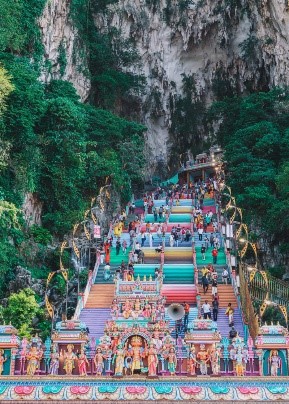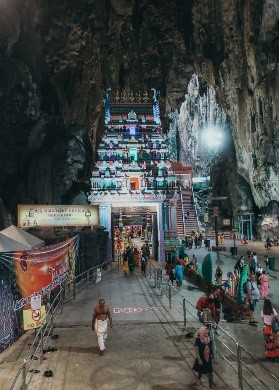Discover Chinese culture at the Thean Hou Temple
Considered by many to be the most beautiful temple in the world, the Thean Hou Temple is one of the most visited tourist attractions in Kuala Lumpur. Since its opening in 1989, it has opened its doors to millions of worshipers, tourists and photographers who want to capture the thousands of red and yellow lanterns. The Temple, built in six tiers, is one of the largest temples in Malaysia and South East Asia and serves as a place of worship as well as a functional space for events such as annual Chinese New Year celebrations, fortune-telling ceremonies, martial arts demonstrations and training sessions, and weddings.
Before you visit the Thean Hou Temple, there are a few things you should know. First, the temple is one of the few free attractions in Kuala Lumpur and with no official entrance fee, a small donation is recommended to support the upkeep of the temple. The Temple is open from 08:00 to 22:00 on most days, but this may change due to special events and celebrations. Unlike other temples in Asia, the Temple is more relaxed and there is no formal dress code for visiting. However, as it remains a place of worship, I suggest avoiding short skirts or shorts out of respect for others.
With designs and architectural elements borrowed from traditional and modern building techniques, the Thean Hou Temple is quite unique in that it incorporates cultural elements from Buddhism, Taoism and Confucianism. There is a lot to admire outside the temple, including the statue of the three wise men, the statues of the twelve Chinese zodiac animals (where you can find your own birth year’s animal and learn more about your personality), a turtle pond, a fountain and a stunning herb garden filled with buzzing bees and hundreds of butterflies. To the right of the main temple you will find a small fountain where the Goddess of Mercy dispenses water from a small jar, more carefully maintained gardens, a large Chinese chess board and some pretty colourful steps that lead to the back of the Temple, where there are more traditional Chinese statues.
The central court and main hall of the Temple is inside on the second floor, which is decorated with hundreds if not thousands of red, orange and yellow Chinese lanterns. Leading away from the centre courtyard is the prayer hall, where devotees worship at three elaborately decorated altars, dedicated to Thean Hou, the Goddess of the Sea, Guan Yin, the Goddess of Mercy and Shui Wei Sheng Niang, the Goddess of the Waterfront. In the middle of the hall and between the altars are two pairs of Kau Cim oracles, from whom visitors can request answers or fortunes. As you walk away from the centre court and prayer hall up the stairs to the next level, keep an eye out for the traditional designs that cover every inch of the temple. Decorated all over with complex finishes and ornate carvings, the detail is incredible. From the upper levels you can also get close-up views of the mosaic dragons and phoenixes that adorn the Temple’s pointed eaves.
The Thean Hou Temple has become one of Kuala Lumpur’s major tourist attractions in its own right and attracts more than 1 million visitors each year, most of whom arrive at 09:00 by bus as part of organised tours. Therefore, if you want to explore the Temple without the crowds and take great pictures, make sure you arrive by 08:00. To get to the Thean Hou Temple by public transport, take the metro or monorail to KL Sentral, from where you must walk to and up the Robson Hill, which takes about half an hour. Note that the last few hundred meters are very steep and can be pretty strenuous in extreme heat. If you are feeling lazy and would rather travel to the temple in airconditioned style, use the Grab app and zip to the temple in a modern taxi for around RM10.
To read more about the Thean Hou Temple, please visit my full travel guide to this fantastic place at Exploring the Thean Hou Temple.
Take a day trip to Batu Caves
If you have an Instagram or Pinterest account, chances are you have seen a myriad of pictures of the famously colourful steps that lead to the Batu Caves. Rated on TripAdvisor as the best day trip from Kuala Lumpur, the Batu Caves have in recent years become one of Asia’s most photographed places that attracts millions of visitors.
Set in a limestone hill that is over 400 million years old, the group of caves slowly formed over years of eroding, accelerated by the Sangai Batu (or Stone River) that flows past the hill and for which the caves were named. The caves were first discovered by the Temaun people of the Orang Asli tribe, but did not make it onto any record until 1879, when it was officially discovered by a hunting party travelling with American zoologist and conservationist William Temple Hornaday.
The caves attracted some media attention and in 1880, a rich Indian Trader, K.T. Pillai, started to promote the caves as a Hindu place of worship and dedicated the cave and consequent temple to the Hindu war god Lord Murugan. It took about 30 years before the first wooden steps were built in 1920 that lead to the Batu Caves. The original wooden steps were soon replaced with 272 concrete steps, which were transformed in August 2018 into the colourful rainbow staircase you will find today.
After making your way up these steps, you will enter the main cave complex, known as the Temple Cave, where you can explore many Hindu shrines in the two large cave caverns. Make sure you explore them and do not only visit the colourful steps. There is of course also the 140 foot (42,7 meter) tall statue of Lord Murugan that looms over the caves. Constructed of 250 tonnes of steel, 300 litres of gold paint and 1 550 m3 of concrete, it is by far the tallest statue in Malaysia, and the third tallest statue of a Hindu deity in the world.
Entrance to the Batu Caves is free, but you will have to pay a few Malaysian ringgits if you would like to go into some of the smaller temples and visit the shrines. As with most temples in Asia, it is best to dress conservatively as you will not be allowed to go up the stairs or visit any of the temples if your knees and shoulders are uncovered. When inside the Temple Cave, act responsibly and always be respectful of the people who visit this fantastic place for religious purposes. Other than hosting thousands of visitors each day, the Batu Caves are also home to an extraordinary number of other living things. Apart from hundreds of tropical plant species that thrive in the humid Malayan climate, the Cave is also a habitat for several species of bat, frog, lizard and snake, and of course the scampering macaque monkeys, who are very cheeky and should be avoided and never fed. They are known to grab bags, sunglasses, hats and any kind of food and drink straight from people’s hands, so make sure you go snack-free and look after your belongings.
Also note that, as the Thaipusam Festival attracts millions of visitors to the steps, cave and temples over a single weekend in late January or early February each year, the area becomes very dirty and littered and is best avoided until about a week after the Festival.
If you are looking for the cheapest way to get from the city to the Caves, use the KTM Komuter train, which will drop you off less than 200 m from the entrance to the Batu Caves. Tickets are available at the KTM Komuter ticket office inside KL Sentral KTM Station for RM2,60 per person one-way. The journey takes about 40 minutes. To take photos and have the caves all to yourself, make sure you get there very early. The first train from KL Sentral to Batu Caves leaves at 06:56 – so make sure you are on it. Remember to check the KTM Komuter timetable a day before you plan on going for any changes or notifications. If you are a solo female traveller, look out for the women-only carriages for some extra piece of mind, especially if you are travelling early in the morning.
To read more about the Batu Caves, please visit my full travel guide to this fantastic place at Batu Caves as a day trip from Kuala Lumpur.
Also read: Kuala Lumpur Part 1





















